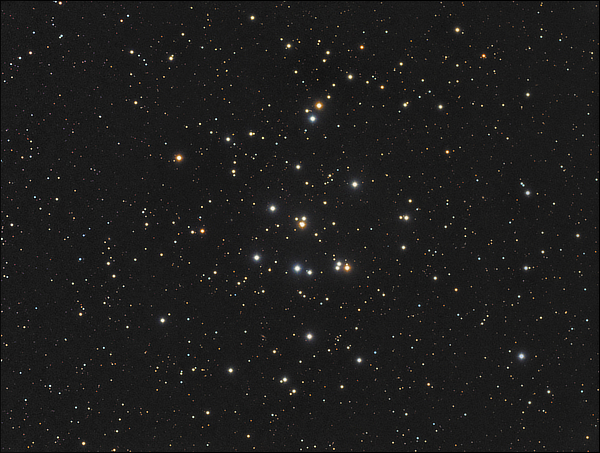Messier 44 in Cancer
February 2024 - Nebula and Cluster of the Month
February is a month particularly devoid of clusters and nebulae in the northern hemisphere. Apart from the two Messier-listed clusters, there is virtually nothing to be seen. Those of us with access to the southern skies have a much better deal of it this month. If you are in the UK but have exceptionally good skies and a clear southern horizon, you may just be able to glimpse the lovely NGC 2627 in Pyxis, though at a declination of -30°, this will be available to very few in the UK.
We UK-bound observers therefore have a choice of two open clusters to observe this month. I covered M67 last year, so this year we turn to the second and final object, the wonderful M44, called since ancient times ‘Praesepe’, a strange-sounding Latin word that means ‘manger’ or ‘cot’. The two stars that nestle alongside the cluster, one to the north and one to the south, γ and δ Cancri, are called Asellus Borealis and Asellus Australis, respectively. The word ‘Asellus’ is Latin for donkey or ass. Apparently, these two stars and the cluster (which remember can only have looked nebulous to pre-telescopic eyes) represent the two donkeys and the manger from where they came, on which Dionysus and Silenus (both presumably terribly drunk at the time) rode into battle against the Titans in Greek legend. The braying of the terrified donkeys so scared the Titans that they scattered and were easily defeated by the gods (at least according to Eratosthenes). Make of that what you will.

The object is listed by Hipparchus in his star catalogue of 130BC as a ‘cloudy star’. Other prominent pre-telescopic observers who catalogued it were the Greek Ptolemy, the Persian Ulugh Beg, the Danish Tycho Brahe and the Polish Johannes Hevelius.
Galileo turned his little telescope to it in 1609. He was the first to see its true nature as a cluster of stars, writing ‘The nebula called Praesepe contains not one star only but a mass of more than 40 small stars. We have noted 36 beside the Aselli.’ This demonstrates that the small telescope constructed by Galileo could reach down at least to magnitude 9.5.
Charles Messier published his first catalogue in 1771. It contained 45 objects, the final two of which seem to have been added (some may say cynically) to make up the numbers to a multiple of five. Messiers 44 and 45 had both been known since antiquity and there really was no need to include two such obvious objects that no comet-hunter worth their salt would ever confuse for a comet.
On to the cluster itself, then. M44 is nestled between and slightly to the west of γ and δ Cancri, magnitudes 4.7 and 3.9, the aforementioned ‘Aselli’. These two stars in turn lie at the centre of the wonky-K shape of Cancer. Even if it wasn’t so bright, M44 would still be easy to find.
M44 shines at magnitude 3.1, making it a naked-eye object from all but the worst light-polluted sites. Diameter estimates vary from 70’ to 95’, so this object will only fit in the lowest-power fields. Rich-field telescopes show it best, but it looks fabulous in binoculars as well, especially if they are mounted.
The number of member stars varies considerably from source to source. Uranometria states a mere 50, Archinal & Hynes stretch to 161, whereas Wikipedia plumps for a far more impressive 1,000.
The Trumpler classification is II3m (detached with little central condensation, wide magnitude range of member stars, moderate richness (50 – 100 stars)).
The brightest star in the cluster is magnitude 6.3.
The distance has recently been refined by the Hipparcos satellite to 182 parsecs, or about 590 light-years, making this one of the closest open clusters to us. Interestingly, another nearby open cluster, the Hyades in Taurus, shares the same proper motion and age profile as M44, though the Hyades might be slightly older (625My as opposed to 600My for M44). This suggests to some that the two clusters have a common origin.
Visually, M44 is one of the more impressive open clusters, although as mentioned, it does need a rich-field or very low power, as it’s so big.
The first impression I get is always that the centre of the cluster is defined by a keystone-shaped asterism, very much like a smaller version of the Hercules keystone. In fact, the whole cluster looks a little like a smaller version of Hercules. The brightest stars, of sixth and seventh magnitude, are brilliant, but as the Trumpler classification suggests, there are stars of all brightnesses. The brightest stars are of spectral type A, F and G, giving the cluster a little colour. Doubles and multiples abound, making this object a delight to spend a little time studying. The higher power eschewed for the overall view can now be employed to investigate the many doubles and multiples.
Richard Hinkley Allen in ‘Star Names and Their Meanings’ reports that the Chinese name for M44 translates as ‘The Exhalation of Piled-Up Corpses’. Which is nice.
M44 sits in front of a rich stream of galaxies, though the brightest of these, NGC 2624, is just magnitude 14.9. All the others are below 15th magnitude. If you have good skies and a large telescope, there is much here to investigate, though of course, that’s beyond the scope of this article.
| Object | RA | Dec | Type | Magnitude |
|---|---|---|---|---|
| M 44 (NGC 2632) | 08h 40m 22s | +19° 40’ 17” | Open cluster | 3.1 |